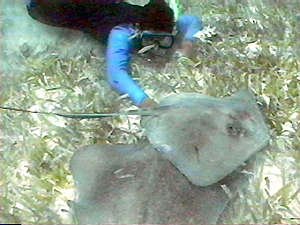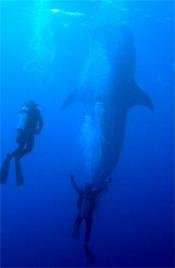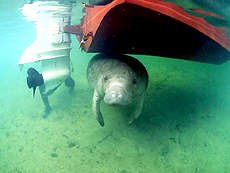There is a great variety of reef types and diving & snorkeling experiences in Belize. The Barrier Reef is 185 meandering miles (298 km) of unspoiled beauty. It varies from 8 to 16 miles (13-26 km) from the mainland to less than one mile (1.6 km) offshore from Ambergris Caye. Much of it is totally unexplored and all of it is easily accessible by boat. The reef is like a gigantic wall running parallel to the coast. Between the mainland and the reef are shallow, sandy waters with numerous mangrove-covered islands (cayes).
 Map of Ambergris Caye and Belize dive sites. We also have an extensive selection of diving and snorkeling photographs.
Map of Ambergris Caye and Belize dive sites. We also have an extensive selection of diving and snorkeling photographs.
Ambergris Caye is the largest island in Belize, and the main destination for travellers to this western Caribbean nation. San Pedro is the only town on the island. Ambergris Caye has been the hub of Belizean area maritime trade for centuries. Fishing, coconuts, and chicle were historic means of islanders support, but the last thirty years have led to a large growth in both the Belize dive and scuba trade, and ecotourism. The rich variety of things to do in San Pedro Town makes Ambergris Caye the gateway to Belize.
Belize is a democratic, English speaking nation, once known as British Honduras. The weather is mild, the beaches are beautiful, and the history is rich, Belize is a land of swaying palm trees and colorful sunsets.
While much of the flora and fauna is similar throughout the reef system, there are individual differences to be found everywhere. A particular type of fish may be seen on almost every dive, but during mating season it may congregate in only one or two areas in great numbers. Hard corals, gorgonians, sea fans, tunicates, and shellfish of amazing variety populate Belize coastal waters, but the predominance of one in a particular stretch of reef may give that area its name. Similarly, there are areas where grouper are known to shoal, others where large stingray are prolific or where the diver may encounter a whale shark. The manta ray and spotted eagle ray Ambergris Caye is justly the most popular attraction to the tourists who come to Belize. The factor that most contributes to this is the unbelievably superb diving & snorkeling conditions. Accessibility to the dive sites, such as Lighthouse Reef, Turneffe Islands, as well as many excellent sites right off Ambergris Caye, combined with excellent weather conditions, clear warm water, the variety of dive sites and in the unlikely chance that a diving accident should occur, the hyperbaric chamber is minutes away from any of the dive sites. For general information on diving & snorkeling in Belize.are fairly common, and the diver can reasonably expect to see one of these magnificent creatures during his visit. Hammerhead shark,Caribbean reef shark and even the oceanic white tip shark are seen occasionally, but these lucky sightings are rare.
Conservation and protection of the natural resources is very important for the government and people of Belize. Proof of this is the designation of one of the most popular dive sites off Ambergris Caye, Hol Chan, a marine reserve. Strict supervision is in place and no fishing or removal of coral is permitted. Mooring buoys have been installed so that anchors may not destroy the coral.
 San Pedro Town is the site of major development which evolved from a laid back fishing village to an important tourist attraction. The pace is slow, the people are very friendly, the streets are still dirt and sand and the resorts are small and intimate.
San Pedro Town is the site of major development which evolved from a laid back fishing village to an important tourist attraction. The pace is slow, the people are very friendly, the streets are still dirt and sand and the resorts are small and intimate.
Training is the basis of new regulation instituted by government this year to improve the services guides render to tourists. To become a dive guide in Belize, one first of all has to be Belizean, study to become a dive master, work with an experienced dive master for a considerable period of time, know the dive sites well, be versed in first aid and

safety, and be of sound character Skin Diver magazine describes a typical dive area off San Pedro as an area outside the reef where “the corals gradually slope to about 50 feet along a bottom of scattered heads, seafans, and gorgonians. From about 60 to 90 feet, the corals form immense spur and groove surge channels perpendicular to the shoreline. These high profile channels are adorned by yellow tube and azure vase sponges, large barrel sponges and a respectable amount of marine life.The San Pedro Tourist Guide Association which is 175 members strong plays a significant role in making sure that guides perform well, and guiding is safe.

The basic San Pedro dive boat is an island built skiff in the 20 to 26 foot range powered by twin outboard motors. These are fairly fast, traveling to most dive sites within 15 to 20 minutes. Dives are usually done one dive in the morning at 9:00 a.m. and another dive at 2:00 p.m. in the afternoon. The cost for these two dives, including tanks and weights, ranges between $45.00 to $55.00 U.S. for the two dives the same day. Dives are also arranged to suit diver’s schedules. Night dives at the Hol Chan Marine Reserve are done regularly at a cost of$30.00 to $40.00 U.S. Most diving is done outside the reef at depths ranging from 40 to 100 feet. Marine life is more abundant in the Hol Chan Marine Reserve because it is protected and also because the tidal currents bring nutrients to the area which attract a variety of marine life. Rays and schooling jacks are frequently seen, and the most common reef tropicals such as groupers, coneys, angelfish and barracuda are almost sure to be seen. For a more interesting and convoluted bottom featuring caves full of copper sweepers and a resident school of horse-eyed jacks, the dive site Caverns, just outside the Mata Cut, is another local favorite.”
Rays and schooling jacks are frequently seen, and the most common reef tropicals such as groupers, coneys, angelfish and barracuda are almost sure to be seen. For a more interesting and convoluted bottom featuring caves full of copper sweepers and a resident school of horse-eyed jacks, the dive site Caverns, just outside the Mata Cut, is another local favorite.”
The 1/2 mile from the beachline to the reefline has an abundance of wonders.
A detailed list of the various mammals, invertebrates, fish, birds, and other creatures that inhabit these waters can be read by clicking here.
Click here for a thorough examination of the plant life on and around the island. The tree, bushes, underwater grasses, a botanical sweep of the island…
Several professionally run dive shops serve the divers with clean air and well kept diving and snorkeling equipment. Dive instructors work out of these dive shops providing full PADI and NAUl certifcation, referrals for divers wishing to complete the open water certification, and “discover diving” for the snorkelers who dare taste the exciting world of scuba diving.
 Scuba diving & snorkeling have come a long way in Ambergris Caye! Safety, protection of the natural resources and convenience to the diver are very important to our diving community. The government and people of Belize have decided that development of our tourist industry will be planned; it will grow slowly and gradually, never losing sight of the vital importance of protection of our precious reef and the dangers of over-development. But, please don’t take my word for it, come check it out yourselves!
Scuba diving & snorkeling have come a long way in Ambergris Caye! Safety, protection of the natural resources and convenience to the diver are very important to our diving community. The government and people of Belize have decided that development of our tourist industry will be planned; it will grow slowly and gradually, never losing sight of the vital importance of protection of our precious reef and the dangers of over-development. But, please don’t take my word for it, come check it out yourselves!
For those interested in diving with Nitrox, the dive operators on Ambergris Caye that handle it are Ramons and the Caye Dive Resort.
